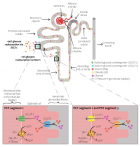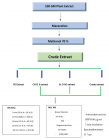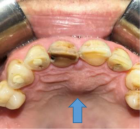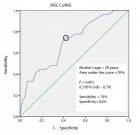Abstract
Short Review
Endothelial Repair and Endothelial Cell-Derived Secretome
Alexander E. Berezin*
Published: 09 January, 2017 | Volume 1 - Issue 1 | Pages: 001-008
Growing evidence supports the hypothesis that endothelial cell-derived microparticles (MPs) might contribute to the pathogenesis of cardiovascular (CV) disease. Endothelial cell-derived MPs play a pivotal role in the regulation of the endogenous repair system, thrombosis, coagulation, inflammation, immunity and metabolic memory phenomenon. There is evidence that the MPs are secreted actively accompanied to other regulatory molecules. All these actively synthetizing and secreting factors include proteins, adhesion and intercellular signal molecules, peptides, lipids, free DNAs, microRNAs, and even microparticles (MPs) are defined as cellular secretome. The proteomic profile of secretome is under tightly control of genetic and epigenetic mechanisms, which may altered a secretion of the proteins involved into MPs’ organization. Finally, this may contribute the modification of MP’s after their secretion and throughout transfer to the target cells. As a result, communicative ability of endothelial cell-derived MPs may sufficiently worse. Subsequently, cross talk between some components of secretome might modulate delivering cargos of MPs and their regenerative and proliferative capabilities via intercellular signaling networks. The aim of the review is to discuss the effect of various components of secretome on MP-dependent effects on endothelium.
Read Full Article HTML DOI: 0.29328/journal.hjbm.1001001 Cite this Article Read Full Article PDF
Keywords:
Endothelium; Endothelial cells; Secretome; Reparation; Microparticles
References
- Thulin A, Christersson C, Alfredsson J, Siegbahn A. Circulating cell-derived microparticles as biomarkers in cardiovascular disease. Biomark Med. 2016; 10: 1009-1022. Ref.: https://goo.gl/nLzZme
- Berezin AE, Kremzer AA, Martovitskaya YV, Berezina TA, Gromenko EA. Pattern of endothelial progenitor cells and apoptotic endothelial cell-derived microparticles in chronic heart failure patients with preserved and reduced left ventricular ejection fraction. EBioMedicine. 2016; 4: 86-94. Ref.: https://goo.gl/MIhKnC
- Berezin AE, Kremzer AA, Berezina TA, Martovitskaya YV. Pattern of circulating microparticles in chronic heart failure patients with metabolic syndrome: Relevance to neurohumoral and inflammatory activation. BBA Clin. 2015; 4: 69-75. Ref.: https://goo.gl/6GRMvL
- Berezin AE, Kremzer AA, Cammarota G, Zulli A, Petrovic D, et al. Circulating endothelial-derived apoptotic microparticles and insulin resistance in non-diabetic patients with chronic heart failure. Clin Chem Lab Med. 2016; 54: 1259-1267. Ref.: https://goo.gl/b2LNxx
- Berezin AE, Kremzer AA, Berezina TA, Martovitskaya Yu V. The pattern of circulating microparticles in patients with diabetes mellitus with asymptomatic atherosclerosis. Acta Clinica Belgica: International Journal of Clinical and Laboratory Medicine. 2016. Ref.: https://goo.gl/crs4fH
- Berezin AE, Kremzer AA, Martovitskaya YV, Samura TA, Berezina TA, et al. The utility of biomarker risk prediction score in patients with chronic heart failure. Int J Clin Exp Med. 2015; 8: 18255-18264. Ref.: https://goo.gl/WiiK28
- Berezin AE, Kremzer AA, Martovitskaya YV, Samura TA, Berezina TA. The predictive role of circulating microparticles in patients with chronic heart failure. BBA Clin. 2014; 3:18-24. Ref.: https://goo.gl/c6ynVA
- Berezin AE. Impaired Phenotype of Circulating Endothelial-Derived Microparticles: Novel Marker of Cardiovascular Risk. Journal of Cardiology and Therapy. 2015; 2: 273-278 doi:10.17554/j.issn.2309-6861.2015.02.77. Ref.: https://goo.gl/J6iAPl
- Beer L, Mildner M, Gyöngyösi M, Ankersmit HJ. Peripheral blood mononuclear cell secretome for tissue repair. Apoptosis. 2016; 21:1336-1353. Ref.: https://goo.gl/MYrLue
- Berezin A, Zulli A, Kerrigan S, Petrovic D, Kruzliak P. Predictive role of circulating endothelial-derived microparticles in cardiovascular diseases. Clin Biochem. 2015; 48:562-568. Ref.: https://goo.gl/IgVo6k
- Amabile N, Gurin AP, Leroyer A, Mallat Z, Nguyen C. et al. Circulating endothelial microparticles are associated with vascular dysfunction in patients with end-stage renal failure. J Am Soc Nephrol. 2005; 16: 3381-3388. Ref.: https://goo.gl/Nd5YhR
- Pirro M, Schillaci G, Bagaglia F, Menecali C, Paltriccia R. et al. Microparticles derived from endothelial progenitor cells in patients at different cardiovascular risk. Atherosclerosis. 2008; 197: 757-767. Ref.: https://goo.gl/HPnQvy
- Yue WS, Lau KK, Siu CW, Wang M, Yan GH, et al. Impact of glycemic control on circulating endothelial progenitor cells and arterial stiffness in patients with type 2 diabetes mellitus. Cardiovasc Diabetol. 2011; 10: 113. Ref.: https://goo.gl/vHthAr
- Berezin A. The Clinical Utility of Circulating Microparticles’ Measurement in Heart Failure Patients. J Vasc Med Surg. 2016; 4: 275-284.
- Berezin A. “Impaired immune phenotype" of endothelial cell-derived microparticles: the missed link between diabetes-related states and cardiovascular complications? Journal of Data Mining in Genomics & Proteomics. 2016; 7: 195-197.
- Nozaki T, Sugiyama S, Koga H, Sugamura K, Ohba K. et al. Significance of a multiple biomarkers strategy including endothelial dysfunction to improve risk stratification for cardiovascular events in patients at high risk for coronary heart disease. J Am Coll Cardiol. 2009; 54: 601-608 Ref.: https://goo.gl/KkvAke
- Llombart V, García-Berrocoso T, Bech-Serra JJ, Simats A, Bustamante A. et al. Characterization of secretomes from a human blood brain barrier endothelial cells in-vitro model after ischemia by stable isotope labeling with aminoacids in cell culture (SILAC). J Proteomics. 2016; 133: 100-112. Ref.: https://goo.gl/xdRqIX
- Reus TL, Robert AW, Da Costa MB, de Aguiar AM, Stimamiglio MA. Secretome from resident cardiac stromal cells stimulates proliferation, cardiomyogenesis and angiogenesis of progenitor cells. Int J Cardiol. 2016; 221: 396-403. Ref.: https://goo.gl/ZyQO5N
- Khanabdali R, Rosdah AA, Dusting GJ, Lim SY. Harnessing the secretome of cardiac stem cells as therapy for ischemic heart disease. Biochem Pharmacol. 2016; 113: 1-11. Ref.: https://goo.gl/N0GiRU
- Mathivanan S, Ji H, Simpson RJ. Exosomes: extracellular organelles important in intercellular communication. J Proteomics. 2010; 73: 1907-1920. Ref.: https://goo.gl/dtUus1
- Zullo JA, Nadel EP, Rabadi MM, Baskind MJ, Rajdev MA. et al. The Secretome of Hydrogel-Coembedded Endothelial Progenitor Cells and Mesenchymal Stem Cells Instructs Macrophage Polarization in Endotoxemia. Stem Cells Transl Med. 2015; 4: 852-861. Ref.: https://goo.gl/97GvPr
- Ostrowski M, Carmo NB, Krumeich S, Fanget I, Raposo G, et al. Rab27a and Rab27b control different steps of the exosome secretion pathway. Nat Cell Biol. 2010;12:19-30. Ref.: https://goo.gl/OivXpu
- Ullal AJ, Pisetsky DS, Reich C. Use of SYTO 13, a fluorescent dye binding nucleic acids, for the detection of microparticles in in vitro systems. Cytometry A. 2010;77:294-301.Ref.: https://goo.gl/UT9fqB
- Berezin AE. Metabolomics in Heart Failure Patients: Hype and Hope. Biomarkers J. 2016; 2: 21-23.Ref.: https://goo.gl/jfI10Y
- Berezin AE, Mokhnach RE. The promises, methodological discrepancies and pitfalls in measurement of cell-derived extracellular vesicles in diseases. J Biotechnol Biomater, 2016; 6: 232-239. Ref.: https://goo.gl/PTIZHq
- Simak J, Gelderman MP. Cell membrane microparticles in blood and blood products: potentially pathogenic agents and diagnostic markers. Transfus Med Rev. 2006; 20: 1-26. Ref.: https://goo.gl/Ni9d9i
- Reich C, Pisetsky DS. The content of DNA and RNA in microparticles released by Jurkat and HL-60 cells undergoing in vitro apoptosis. Exp Cell Res. 2009; 315: 760-768. Ref.: https://goo.gl/vDbbsC
- Horstman LL, Jy W, Jimenez JJ, Ahn YS. Endothelial microparticles as markers of endothelial dysfunction. Front Biosci. 2004; 9: 1118-1135. Ref.: https://goo.gl/kcI20p
- Mayr M, Grainger D, Mayr U, Leroyer AS, Leseche G, et al. Proteomics, metabolomics, and immunomics on microparticles derived from human atherosclerotic plaques. Circ Cardiovasc Genet. 2009; 2: 379-388. Ref.: https://goo.gl/kau7sG
- Mause SF, Weber C. Microparticles: protagonists of a novel communication network for intercellular information exchange. Circ Res. 2010; 107: 1047-1057. Ref.: https://goo.gl/vQ0S8M
- Helmke A, von Vietinghoff S. Extracellular vesicles as mediators of vascular inflammation in kidney disease. World J Nephrol. 2016; 5: 125-138. Ref.: https://goo.gl/zDxsRC
- Lu Y, Li L, Yan H, Su Q, Huang J, et al. Endothelial microparticles exert differential effects on functions of Th1 in patients with acute coronary syndrome. Int J Cardiol. 2013; 168: 5396-5404. Ref.: https://goo.gl/I8MoUh
- Scanu A, Molnarfi N, Brandt KJ, Gruaz L, Dayer JM, et al. Stimulated T cells generate microparticles, which mimic cellular contact activation of human monocytes: differential regulation of pro- and anti-inflammatory cytokine production by high-density lipoproteins. J Leukoc Biol. 2008; 83: 921-927. Ref.: https://goo.gl/O20y6w
- Zhang Q, Shang M, Zhang M, Wang Y, Chen Y, et al. Microvesicles derived from hypoxia/reoxygenation-treated human umbilical vein endothelial cells promote apoptosis and oxidative stress in H9c2 cardiomyocytes. BMC Cell Biol. 2016 Jun 23; 17: 25. Ref.: https://goo.gl/9QR2zH
- Nomura S, Tandon NN, Nakamura T, Cone J, Fukuhara S, et al. High-shear-stress-induced activation of platelets and microparticles enhances expression of cell adhesion molecules in THP-1 and endothelial cells. Atherosclerosis. 2001; 158: 277-287. Ref.: https://goo.gl/5vOzDc
- Boulanger CM, Scoazec A, Ebrahimian T, Henry P, Mathieu E, et al. Circulating microparticles from patients with myocardial infarction cause endothelial dysfunction. Circulation. 2001; 104: 2649-2652. Ref.: https://goo.gl/lVNu40
- Song JQ, Teng X, Cai Y, Tang CS, Qi YF. Activation of Akt/GSK-3beta signaling pathway is involved in intermedin(1-53) protection against myocardial apoptosis induced by ischemia/reperfusion. Apoptosis. 2009; 14: 1299-1307. Ref.: https://goo.gl/UCtlqw
- Eckers A, Haendeler J. Endothelial cells in health and disease. Antioxid Redox Signal. 2015; 22: 1209-1211. Ref.: https://goo.gl/rLWmZw
- Mukherjee P, Mani S. Methodologies to decipher the cell secretome. Biochim Biophys Acta. 2013; 1834: 2226-2232. Ref.: https://goo.gl/WtxQ61
- Ankersmit HJ, Hoetzenecker K, Dietl W, Soleiman A, Horvat R. et al. Irradiated cultured apoptotic peripheral blood mononuclear cells regenerate infarcted myocardium. Eur J Clin Invest. 2009; 39: 445-456. Ref.: https://goo.gl/pk12y5
- Makridakis M, Roubelakis MG, Vlahou A. Stem cells: insights into the secretome. Biochim Biophys Acta. 2013; 1834: 2380-2384. Ref.: https://goo.gl/BCpmkN
- Lichtenauer M, Mildner M, Hoetzenecker K, Zimmermann M, Podesser BK, et al. Secretome of apoptotic peripheral blood cells (APOSEC) confers cytoprotection to cardiomyocytes and inhibits tissue remodelling after acute myocardial infarction: a preclinical study. Basic Res Cardiol. 2011; 106: 1283-1297. Ref.: https://goo.gl/08Lw4W
- Lichtenauer M, Mildner M, Baumgartner A, Hasun M, Werba G, et al. Intravenous and intramyocardial injection of apoptotic white blood cell suspensions prevents ventricular remodelling by increasing elastin expression in cardiac scar tissue after myocardial infarction. Basic Res Cardiol. 2011; 106: 645-655. Ref.: https://goo.gl/Vrqa9q
- Lichtenauer M, Mildner M, Werba G, Beer L, Hoetzenecker K, et al. Anti-thymocyte globulin induces neoangiogenesis and preserves cardiac function after experimental myocardial infarction. PLoS One. 2012; 7: 52101. Ref.: https://goo.gl/pcj7BP
- Hill J, Zalos G, Halcox J, Schenke W, Waclawiw M, et al. Circulating endothelial progenitor cells, vascular function, and cardiovascular risk. N Engl J Med. 2003; 348: 593-600. Ref.: https://goo.gl/wEj0Nx
- Vlassov AV, Magdaleno S, Setterquist R, Conrad R. Exosomes: current knowledge of their composition, biological functions, and diagnostic and therapeutic potentials. Biochim Biophys Acta. 2012; 1820: 940-948. Ref.: https://goo.gl/1JNAcJ
- Ankrum JA, Miranda OR, Ng KS, Sarkar D, Xu C, K, et al. Engineering cells with intracellular agent-loaded microparticles to control cell phenotype. Nat Protoc. 2014; 9: 233-245. Ref.: https://goo.gl/7L3hES
- Le Bihan MC, Bigot A, Jensen SS, Dennis JL, Rogowska-Wrzesinska A, et al. In-depth analysis of the secretome identifies three major independent secretory pathways in differentiating human myoblasts. J Proteomics. 2012; 77: 344-356. Ref.: https://goo.gl/E0zXyc
- Berezin A. Endothelial progenitor cells dysfunction and impaired tissue reparation: the missed link in diabetes mellitus development. Diabetes & Metabolic Syndrome. 2016. Ref.: https://goo.gl/IqBAiJ
- Berezin A. Bone-Related Proteins as Markers in Vascular Remodeling In: V.R. Preedy (ed.), Biomarkers in Bone Disease: Methods, Discoveries and Applications, Switzerland, Springer, 2016; 1-22. Ref.: https://goo.gl/fXR50H
- Ranganath SH, Levy O, Inamdar MS, Karp JM. Harnessing the mesenchymal stem cell secretome for the treatment of cardiovascular disease. Cell Stem Cell. 2012; 10: 244-258. Ref.: https://goo.gl/PKZtpO
Figures:

Figure 1
Similar Articles
-
Endothelial Repair and Endothelial Cell-Derived SecretomeAlexander E. Berezin*. Endothelial Repair and Endothelial Cell-Derived Secretome . . 2017 doi: 0.29328/journal.hjbm.1001001; 1: 001-008
Recently Viewed
-
Impact of Moringa oleifera Leaf Flour supplement on Weight Gain in Moderately Acutely Malnourished Children in BeninLaleye Flora Tinouade Founmilayo*, Fanou Fogny Nadia and Kayode Polycarpe. Impact of Moringa oleifera Leaf Flour supplement on Weight Gain in Moderately Acutely Malnourished Children in Benin. Arch Food Nutr Sci. 2023: doi: 10.29328/journal.afns.1001052; 7: 070-077
-
Drug Rehabilitation Centre-based Survey on Drug Dependence in District Shimla Himachal PradeshKanishka Saini,Palak Sharma,Bhawna Sharma*,Atul Kumar Dubey,Muskan Bhatnoo,Prajkta Thakur,Vanshika Chandel,Ritika Sinha. Drug Rehabilitation Centre-based Survey on Drug Dependence in District Shimla Himachal Pradesh. J Addict Ther Res. 2025: doi: 10.29328/journal.jatr.1001032; 9: 001-006
-
Feature Processing Methods: Recent Advances and Future TrendsShiying Bai,Lufeng Bai*. Feature Processing Methods: Recent Advances and Future Trends. J Clin Med Exp Images. 2025: doi: 10.29328/journal.jcmei.1001035; 9: 010-014
-
Relationship between Vitamin D Deficiency and Lipopolysaccharides Porphyromonas gingivalis Bacteria in Stunting ChildrenErwin Gunawan*,Ria Puspitawati. Relationship between Vitamin D Deficiency and Lipopolysaccharides Porphyromonas gingivalis Bacteria in Stunting Children. Ann Biomed Sci Eng. 2024: doi: 10.29328/journal.abse.1001033; 8: 059-065
-
Addiction to self-strangulation: a case-reportAurely Ameller*,Yann Le Strat,Marion Cadranel,Celine Portalier, Caroline Dubertret. Addiction to self-strangulation: a case-report . J Addict Ther Res. 2017: doi: 10.29328/journal.jatr.1001003; 1: 016-021
Most Viewed
-
Evaluation of Biostimulants Based on Recovered Protein Hydrolysates from Animal By-products as Plant Growth EnhancersH Pérez-Aguilar*, M Lacruz-Asaro, F Arán-Ais. Evaluation of Biostimulants Based on Recovered Protein Hydrolysates from Animal By-products as Plant Growth Enhancers. J Plant Sci Phytopathol. 2023 doi: 10.29328/journal.jpsp.1001104; 7: 042-047
-
Sinonasal Myxoma Extending into the Orbit in a 4-Year Old: A Case PresentationJulian A Purrinos*, Ramzi Younis. Sinonasal Myxoma Extending into the Orbit in a 4-Year Old: A Case Presentation. Arch Case Rep. 2024 doi: 10.29328/journal.acr.1001099; 8: 075-077
-
Feasibility study of magnetic sensing for detecting single-neuron action potentialsDenis Tonini,Kai Wu,Renata Saha,Jian-Ping Wang*. Feasibility study of magnetic sensing for detecting single-neuron action potentials. Ann Biomed Sci Eng. 2022 doi: 10.29328/journal.abse.1001018; 6: 019-029
-
Pediatric Dysgerminoma: Unveiling a Rare Ovarian TumorFaten Limaiem*, Khalil Saffar, Ahmed Halouani. Pediatric Dysgerminoma: Unveiling a Rare Ovarian Tumor. Arch Case Rep. 2024 doi: 10.29328/journal.acr.1001087; 8: 010-013
-
Physical activity can change the physiological and psychological circumstances during COVID-19 pandemic: A narrative reviewKhashayar Maroufi*. Physical activity can change the physiological and psychological circumstances during COVID-19 pandemic: A narrative review. J Sports Med Ther. 2021 doi: 10.29328/journal.jsmt.1001051; 6: 001-007

HSPI: We're glad you're here. Please click "create a new Query" if you are a new visitor to our website and need further information from us.
If you are already a member of our network and need to keep track of any developments regarding a question you have already submitted, click "take me to my Query."

















































































































































